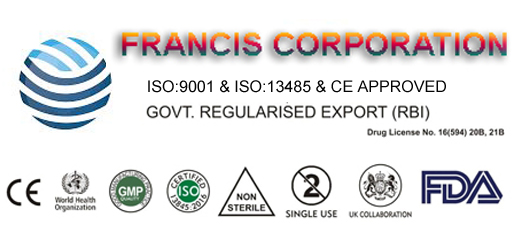Privacy Policy
Francis Corp's Web Site Privacy Statement
The privacy, confidence, and trust of individuals who visit Francis Corp's Products, Inc. web site are important to us. No personal information is collected at this site unless it is provided voluntarily by an individual while participating in an activity that asks for the information. The following paragraphs disclose the information gathering and usage practices for the web site.
Collection of Information
Francis Corp only collects the personal information that is necessary to provide the information or services requested by an individual. "Personal information" refers to any information relating to an identified or identifiable individual who is the subject of the information. This is the same information that an individual might provide when visiting our office and it includes such items as an individual's name, address, or phone number. We also collect statistical information that helps us understand how people are using the web site so we can continually improve our services. The information collected is not associated with any specific individual and no attempt is made to profile individuals who browse the web site.
Use of Information
Francis Corp's Products uses the collected information to respond appropriately to requests. This may be to respond directly to you or to improve the website. E-mail or other information requests sent to Francis Corp's Products may be retained for future use by Francis Corp's Products, Inc. only. Francis Corp's Products will never sell, trade or distribute your personal information.
Cookies
Cookies are short and simple text files that are stored on a user's computer hard drive by web sites. They are used to keep track of and store information so the user does not have to supply the information multiple times. The information that is collected through cookies at this site is handled in the same manner as other information collected here. You can configure your web browser to refuse cookies or to notify you when a web site attempts to send you a cookie. You can also check your hard drive for cookie files and delete them from your computer.
Website Security
Francis Corp is committed to the security of the information that is either available from or collected by this web site. Francis Corp's Products has taken multiple steps to safeguard the integrity of its telecommunications and computing infrastructure, including but not limited to, authentication, monitoring, auditing, and encryption.
Links to Other Sites
This web site may have links to other web sites. Francis Corp's Products is not responsible for the content or privacy practices of these sites and suggests you review their privacy statements.
Under 13 / children
Francis Corp's Products will not knowingly collect information about persons under the age of 13 without prior parental consent. If you are under the age of 13 you must ask a parent or guardian for help.
Disclaimers and Limitation of Liability
Francis Corp's site is provided on an "AS IS," "as available" basis. Neither Francis Corp's Products nor its affiliates, subsidiaries, or designees nor each of their respective officers, directors, employees, agents, third-party content providers, designers, contractors, distributors, merchants, sponsors, licensors or the like (collectively, "associates") warrant that use of Francis Corp's Products, Inc. site will be uninterrupted or error-free. Neither Francis Corp's Products, Inc. nor its associates warrant the accuracy, integrity or completeness of the content provided on Francis Corp's Products, Inc. site or the products or services offered for sale on Francis Corp's Products, Inc. Further, Francis Corp's Products, Inc. makes no representation that content provided on Francis Corp's Products, Inc. site is applicable or appropriate for use in locations outside of the United States. Francis Corp's Products, Inc. specifically disclaims warranties of any kind, either expressed or implied, including but not limited to warranties of title or implied warranties of merchantability or fitness for a particular purpose. No oral advice or written information given by Francis Corp's Products, Inc., nor its associates, shall create a warranty. You expressly agree that use of Francis Corp's Products, Inc. site is at your sole risk.
Under no circumstances shall Francis Corp's Products, Inc. or its associates be liable for any direct, indirect, incidental, special or consequential damages that result from the use of or inability to use Francis Corp's Products, Inc. site, including but not limited to reliance by a user on any information obtained at Francis Corp's Products, Inc. site, or that result from mistakes, omissions, interruptions, deletion of files or email, errors, defects, viruses, delays in operation or transmission, or any failure of performance, whether or not resulting from acts of God, communications failure, theft, destruction or unauthorized access to Francis Corp's Products, Inc. records, programs or services. The foregoing Limitation of Liability shall apply whether in an action of contract, negligence or other tortuous action, even if an authorized representative of Francis Corp's Products, Inc. has been advised of or should have knowledge of the possibility of such damages. User hereby acknowledges that this paragraph shall apply to all content, merchandise and services available through Francis Corp's Products, Inc. site. Because some states do not allow the exclusion or Limitation of Liability for consequential or incidental damages, in such states liability is limited to the fullest extent permitted by law.
Errors will be corrected where discovered, and Francis Corp's Products, Inc.. reserves the right to revoke any stated offer and to correct any errors, inaccuracies or omissions. Please note that Francis Corp's Products, Inc. reserves the right to cancel or refuse any order placed based on incorrect pricing or availability information.
While Francis Corp's Products takes steps to ensure the accuracy and completeness of product and third-party services provided, please refer to the originator of information for details, for example the manufacturer and/or web site for complete details.
